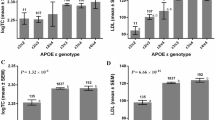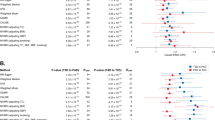Abstract
Aims/hypothesis
Dyslipidaemia, a common feature of type 2 diabetes, is characterised by an increase in atherogenic particles, quantifiable through apolipoprotein B (ApoB) levels. Genetic studies of lipid levels have focused on Europeans; a study in South Asians could identify novel genes.
Methods
We tested 31,739 single nucleotide polymorphisms (SNPs) from ∼2,000 genes in 2,573 South Asians from the epidemiological arm of the Diabetes Reduction Assessment with Ramipril and Rosiglitazone Medication (DREAM) study (EpiDREAM) for association with ApoB and we tested two novel associations for replication in 1,181 South Asians from the INTERHEART case–control study.
Results
The SNP, rs4664443, within DPP4 was associated with ApoB (p = 7.98 × 10−5) in EpiDREAM. The observed association was replicated in the INTERHEART South Asians (one-sided p = 9.65 × 10−3; combined two-sided p = 4.68 × 10−6). The rs4664443 SNP was not associated with ApoB among five other EpiDREAM ethnicities. However, because South Asians had a significantly lower mean BMI compared with other EpiDREAM ethnicities, we tested for and found an interaction between rs4664443 and BMI for ApoB among the Europeans, the largest subgroup in EpiDREAM (p = 4.14 × 10−3 for interaction), observing an association with ApoB in Europeans with a BMI <25 kg/m2 (p = 2.35 × 10−3), but not with a BMI ≥25 kg/m2 (p = 0.21). The association between rs4664443 and ApoB among all EpiDREAM individuals with BMI <25 kg/m2 was significant (n = 2,972; p = 1.44 × 10−5) compared with those with a BMI ≥25 kg/m2 (n = 11,559; p = 0.81), and there was evidence of association among all genotyped individuals with a BMI <25 kg/m2, including the INTERHEART South Asians (n = 3,601; p = 9.52 × 10−7).
Conclusion/interpretation
Variation at the DPP4 locus is associated with ApoB in South Asians and displays heterogeneity related to BMI in other ethnicities.



Similar content being viewed by others

Abbreviations
- ApoB:
-
Apolipoprotein B
- CVD:
-
Cardiovascular disease
- DPP-4:
-
Dipeptidyl peptidase-4
- DREAM:
-
Diabetes Reduction Assessment with Ramipril and Rosiglitazone Medication
- EpiDREAM:
-
Epidemiological arm of the DREAM study
- EXAMINE:
-
Examination of Cardiovascular Outcomes with Alogliptin Versus Standard of Care in Subjects with Type 2 Diabetes and Acute Coronary Syndrome
- GIP:
-
Glucose-dependent insulinotropic peptide
- GIPR:
-
Glucose-dependent insulinotropic peptide receptor
- GLGC:
-
Global Lipids Genetics Consortium
- GLP-1:
-
Glucagon-like peptide-1
- GLP-1R:
-
Glucagon-like peptide-1 receptor
- GWAS:
-
Genome-wide association studies
- IBC:
-
ITMAT/Broad/CARe
- MAF:
-
Minor allele frequency
- MI:
-
Myocardial infarction
- PCSK1:
-
Proprotein convertase subtilisin/kexin type 1
- SAVOR-TIMI 53:
-
Saxagliptin Assessment of Vascular Outcomes Recorded in Patients with Diabetes Mellitus—Thrombolysis in Myocardial Infarction 53
- SNP:
-
Single nucleotide polymorphism
References
McKeigue PM, Marmot MG, Syndercombe Court YD, Cottier DE, Rahman S, Riemersma RA (1988) Diabetes, hyperinsulinaemia, and coronary risk factors in Bangladeshis in east London. Br Heart J 60:390–396
Yusuf S, Hawken S, Ounpuu S et al (2004) Effect of potentially modifiable risk factors associated with myocardial infarction in 52 countries (the INTERHEART study): case-control study. Lancet 364:937–952
Joshi P, Islam S, Pais P et al (2007) Risk factors for early myocardial infarction in South Asians compared with individuals in other countries. J Am Med Assoc 297:286–294
Ramachandran A, Snehalatha C, Viswanathan V, Viswanathan M, Haffner SM (1997) Risk of noninsulin dependent diabetes mellitus conferred by obesity and central adiposity in different ethnic groups: a comparative analysis between Asian Indians, Mexican Americans and Whites. Diabetes Res Clin Pract 36:121–125
Mather HM, Chaturvedi N, Fuller JH (1998) Mortality and morbidity from diabetes in South Asians and Europeans: 11-year follow-up of the Southall Diabetes Survey, London, UK. Diabet Med 15:53–59
Teslovich TM, Musunuru K, Smith AV et al (2010) Biological, clinical and population relevance of 95 loci for blood lipids. Nature 466:707–713
Rosenberg NA, Huang L, Jewett EM, Szpiech ZA, Jankovic I, Boehnke M (2010) Genome-wide association studies in diverse populations. Nat Rev Gen 11:356–366
Mooradian AD (2009) Dyslipidemia in type 2 diabetes mellitus. Nat Clin Pract Endocrinol Metab 5:150–159
Pischon T, Girman CJ, Sacks FM, Rifai N, Stampfer MJ, Rimm EB (2005) Non-high-density lipoprotein cholesterol and apolipoprotein B in the prediction of coronary heart disease in men. Circulation 112:3375–3383
Gerstein HC, Yusuf S, Bosch J et al (2006) Effect of rosiglitazone on the frequency of diabetes in patients with impaired glucose tolerance or impaired fasting glucose: a randomised controlled trial. Lancet 368:1096–1105
Anand SS, Dagenais GR, Mohan V et al (2012) Glucose levels are associated with cardiovascular disease and death in an international cohort of normal glycaemic and dysglycaemic men and women: the EpiDREAM cohort study. Eur J Prev Cardiol 19:755–764
Anand SS, Xie C, Pare G et al (2009) Genetic variants associated with myocardial infarction risk factors in over 8000 individuals from five ethnic groups: the INTERHEART Genetics Study. Circ Cardiovasc Genet 2:16–25
Keating BJ, Tischfield S, Murray SS et al (2008) Concept, design and implementation of a cardiovascular gene-centric 50 k SNP array for large-scale genomic association studies. PloS one 3:e3583
Purcell S, Neale B, Todd-Brown K et al (2007) PLINK: a tool set for whole-genome association and population-based linkage analyses. Am J Hum Genet 81:559–575
Timpson NJ, Lindgren CM, Weedon MN et al (2009) Adiposity-related heterogeneity in patterns of type 2 diabetes susceptibility observed in genome-wide association data. Diabetes 58:505–510
Perry JR, Voight BF, Yengo L et al (2012) Stratifying type 2 diabetes cases by BMI identifies genetic risk variants in LAMA1 and enrichment for risk variants in lean compared to obese cases. PLoS genetics 8:e1002741
Kooner JS, Saleheen D, Sim X et al (2011) Genome-wide association study in individuals of South Asian ancestry identifies six new type 2 diabetes susceptibility loci. Nat Genet 43:984–989
Bouchard L, Faucher G, Tchernof A et al (2009) Comprehensive genetic analysis of the dipeptidyl peptidase-4 gene and cardiovascular disease risk factors in obese individuals. Acta Diabetol 46:13–21
Turcot V, Bouchard L, Faucher G et al (2011) DPP4 gene DNA methylation in the omentum is associated with its gene expression and plasma lipid profile in severe obesity. Obesity (Silver Spring) 19:388–395
Sell H, Bluher M, Kloting N et al (2013) Adipose dipeptidyl peptidase-4 and obesity: correlation with insulin resistance and depot-specific release from adipose tissue in vivo and in vitro. Diabetes Care 36:4083–4090
Bolli G, Dotta F, Colin L, Minic B, Goodman M (2009) Comparison of vildagliptin and pioglitazone in patients with type 2 diabetes inadequately controlled with metformin. Diabetes Obes Metab 11:589–595
Rosenstock J, Baron MA, Dejager S, Mills D, Schweizer A (2007) Comparison of vildagliptin and rosiglitazone monotherapy in patients with type 2 diabetes: a 24-week, double-blind, randomized trial. Diabetes Care 30:217–223
Charbonnel B, Karasik A, Liu J, Wu M, Meininger G (2006) Efficacy and safety of the dipeptidyl peptidase-4 inhibitor sitagliptin added to ongoing metformin therapy in patients with type 2 diabetes inadequately controlled with metformin alone. Diabetes Care 29:2638–2643
Ferrannini E, Fonseca V, Zinman B et al (2009) Fifty-two-week efficacy and safety of vildagliptin vs. glimepiride in patients with type 2 diabetes mellitus inadequately controlled on metformin monotherapy. Diabetes Obes Metab 11:157–166
Rizzo M, Rizvi AA, Spinas GA, Rini GB, Berneis K (2009) Glucose lowering and anti-atherogenic effects of incretin-based therapies: GLP-1 analogues and DPP-4-inhibitors. Expert Opin Invest Drugs 18:1495–1503
Horton ES, Silberman C, Davis KL, Berria R (2010) Weight loss, glycemic control, and changes in cardiovascular biomarkers in patients with type 2 diabetes receiving incretin therapies or insulin in a large cohort database. Diabetes Care 33:1759–1765
Kubota A, Maeda H, Kanamori A et al (2012) Pleiotropic effects of sitagliptin in the treatment of type 2 diabetes mellitus patients. J Clin Med Res 4:309–313
Monami M, Lamanna C, Desideri CM, Mannucci E (2012) DPP-4 inhibitors and lipids: systematic review and meta-analysis. Adv Ther 29:14–25
Monami M, Vitale V, Ambrosio ML et al (2012) Effects on lipid profile of dipeptidyl peptidase 4 inhibitors, pioglitazone, acarbose, and sulfonylureas: meta-analysis of placebo-controlled trials. Adv Ther 29:736–746
Flock G, Baggio LL, Longuet C, Drucker DJ (2007) Incretin receptors for glucagon-like peptide 1 and glucose-dependent insulinotropic polypeptide are essential for the sustained metabolic actions of vildagliptin in mice. Diabetes 56:3006–3013
Matikainen N, Manttari S, Schweizer A et al (2006) Vildagliptin therapy reduces postprandial intestinal triglyceride-rich lipoprotein particles in patients with type 2 diabetes. Diabetologia 49:2049–2057
Kim SA, Shim WH, Lee EH et al (2011) Predictive clinical parameters for the therapeutic efficacy of sitagliptin in Korean type 2 diabetes mellitus. Diabetes Metab J 35:159–165
Drucker DJ, Nauck MA (2006) The incretin system: glucagon-like peptide-1 receptor agonists and dipeptidyl peptidase-4 inhibitors in type 2 diabetes. Lancet 368:1696–1705
Rouille Y, Kantengwa S, Irminger JC, Halban PA (1997) Role of the prohormone convertase PC3 in the processing of proglucagon to glucagon-like peptide 1. J Biol Chem 272:32810–32816
Benzinou M, Creemers JW, Choquet H et al (2008) Common nonsynonymous variants in PCSK1 confer risk of obesity. Nat Genet 40:943–945
Saxena R, Hivert MF, Langenberg C et al (2010) Genetic variation in GIPR influences the glucose and insulin responses to an oral glucose challenge. Nat Genet 42:142–148
Speliotes EK, Willer CJ, Berndt SI et al (2010) Association analyses of 249,796 individuals reveal 18 new loci associated with body mass index. Nat Genet 42:937–948
Ussher JR, Drucker DJ (2012) Cardiovascular biology of the incretin system. Endocr Rev 33:187–215
Monami M, Ahren B, Dicembrini I, Mannucci E (2013) Dipeptidyl peptidase-4 inhibitors and cardiovascular risk: a meta-analysis of randomized clinical trials. Diabetes Obes Metab 15:112–120
Scirica BM, Bhatt DL, Braunwald E et al (2013) Saxagliptin and cardiovascular outcomes in patients with type 2 diabetes mellitus. N Engl J Med 369:1317–1326
White WB, Cannon CP, Heller SR et al (2013) Alogliptin after acute coronary syndrome in patients with type 2 diabetes. N Engl J Med 369:1327–1335
Acknowledgements
Sonia S. Anand holds the Heart and Stroke Foundation of Ontario Michael G. DeGroote endowed Chair in Population Health, and a Canada Research Chair in Ethnicity and Cardiovascular Disease. Hertzel Gerstein holds the Population Health Research Institute Chair in Diabetes Research sponsored by Aventis. Salim Yusuf is supported by an endowed chair from the Heart and Stroke Foundation of Ontario. Swneke D. Bailey held a graduate scholarship from McGill University Health Centre Research Institute and the Gerald Clavet fellowship. The authors thank Lise Coderre (University of Montreal, QC, Canada), Dana Bailey (McGill University, Montreal, QC, Canada), Marie-Claude Vohl (Laval University, Quebec City, QC, Canada), Line Dufresne (McGill University, Montreal, QC, Canada) and Allan Sniderman (McGill University, Montreal, QC, Canada) for helpful discussions. The comments of three anonymous reviewers also improved the manuscript. We thank our research staff and all individuals who participated in DREAM, EpiDREAM and INTERHEART.
Funding
This work was funded by a Canadian Institutes of Health Research (CIHR) university/industry grant with industry partners Sanofi-Aventis and GlaxoSmithKline (GSK), and the Heart and Stroke Foundation of Ontario. The main DREAM trial was funded by CIHR, GSK, Sanofi-Aventis and King Pharma.
Duality of interest
The authors declare that there is no duality of interest associated with this manuscript.
Contribution statement
SDB designed the study, analysed the data and drafted the manuscript. CX analysed the data and revised the manuscript. GP, JCE and SSA contributed to the study design and revised the manuscript. AM, VM, SY and HG acquired the data and revised the manuscript. All authors approved the final published version.
Author information
Authors and Affiliations
Consortia
Corresponding authors
Electronic supplementary material
Below is the link to the electronic supplementary material.
ESM Fig. 1
(PDF 296 kb)
Rights and permissions
About this article
Cite this article
Bailey, S.D., Xie, C., Paré, G. et al. Variation at the DPP4 locus influences apolipoprotein B levels in South Asians and exhibits heterogeneity in Europeans related to BMI. Diabetologia 57, 738–745 (2014). https://doi.org/10.1007/s00125-013-3142-3
Received:
Accepted:
Published:
Issue Date:
DOI: https://doi.org/10.1007/s00125-013-3142-3



